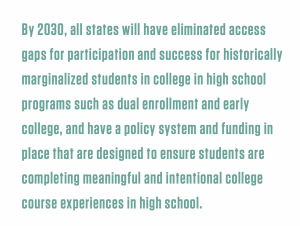Late last year, the College in High School Alliance (CHSA) released “The Next Phase of Dual Enrollment Policy: A Vision for the Field,” laying out a set of critical priorities to ensure all learners get the full benefit of early postsecondary opportunities. As a member of CHSA’s Steering Committee, Advance CTE is excited about the potential—and ambition—of this new vision and what it can mean for learners, in Career Technical Education (CTE) and beyond, across the country.
The vision starts with a goal: states eliminating access gaps for participation and success for historically marginalized students in college in high school programs by 2030. To achieve this goal, it will take a mix of critical state- and national-level imperatives and commitments, including:
-
State Imperatives:
- Setting a Statewide Vision (and goal) for Dual Enrollment informed by the experiences and needs of learners and designed with intention about how it can fit into other statewide priorities, such as CTE and career pathways.
- Doubling Down on the Equity Mission by intentionally removing barriers and providing supports for historically underrepresented students in dual enrollment programs, such as learners with disabilities, learners of color and learners experiencing low income.
- Focusing Policy on Intentional Dual Enrollment Experiences to ensure learners only engage in “intentional acts of dual enrollment.” This is particularly relevant for CTE learners as dual enrollment courses should be aligned with their programs of study, as encouraged by the Carl D. Perkins Career and Technical Education Act (Perkins V).
-
-
National Imperatives:
-
- Setting a National Vision for Dual Enrollment by Raising Expectations for Policy Support, which includes having a common federal definition that is more comprehensive than what is in law now and signals clearer expectations for quality and program design.
- Aligning the Field on Key Terms in Policy, given the vast array of state-level definitions and interpretations for college in high school programs (within and across states).
- Examining New and Emerging Policy Trends to ensure quality assurance and equitable access in areas such as online programming and creative funding models.
Importantly, this vision was not developed in a vacuum. Rather, it is the result of a year-long strategic planning process that engaged CHSA’s steering committee members (Achieving the Dream, Advance CTE, Bard Early College, JFF, KnowledgeWorks, The Middle College National Consortium and The National Alliance of Concurrent Enrollment Partnerships) as well as policymakers and practitioners from across the nation. It builds on years of policy adoption and implementation—elevating what has worked and where more attention is critically needed. That is key as it will take individuals at all levels working in concert to advance and achieve this new vision for dual enrollment.
Going forward, CHSA is committed to making this vision a reality at the state and national levels by publishing new resources that elaborate upon the various components of this vision; providing direct technical assistance to states to help them develop visions that promote equity, set inclusive goals and expand intentional dual enrollment; and convening policymakers to support ongoing collaboration in this space.
As noted in Without Limits: A Shared Vision for Career Technical Education, “the current landscape of college in high school and postsecondary transfer policies and programs is overly complicated, often results in loss of credit and does not consistently support equitable access and success.” As dual enrollment rates continue to rise and more learners, including CTE learners, participate in college in high school opportunities, it is more important than ever that we ensure our systems are designed to be equitable, meaningful and intentional. Advance CTE is excited and proud to be part of this work.
 Relevant Resources
Relevant Resources
- The State of CTE: Early Postsecondary Opportunities
- Unlocking Potential: A State Policy Roadmap for Equity and Quality in College in High School Programs
- Blog: 5 Strategies to Strengthen Equity in Early Postsecondary Opportunity Participation and Completion
Kate Kreamer, Executive Director
Tags: Access and Equity, college in high school, CTE Vision, CTE Without Limits, Dual and Concurrent Enrollment, JFF, Perkins V, Program Alignment, systems alignment

